https://en.wikipedia.org/wiki/Joseph_Haydn
31/03/1732
31/05/1809
He was instrumental in the development of chamber music such as the piano trio[2] and his contributions to musical form have earned him the epithets “Father of the Symphony” and “Father of the String Quartet”. Haydn spent much of his career as a court musician for the wealthy Esterházy family at their remote estate. Until the later part of his life, this isolated him from other composers and trends in music so that he was, as he put it, “forced to become original”. Yet his music circulated widely, and for much of his career he was the most celebrated composer in Europe. He was a friend and mentor of Mozart, a teacher of Beethoven, and the older brother of composer Michael Haydn.
1732: Neix a Rohrau. Infantesa humil, passava gana
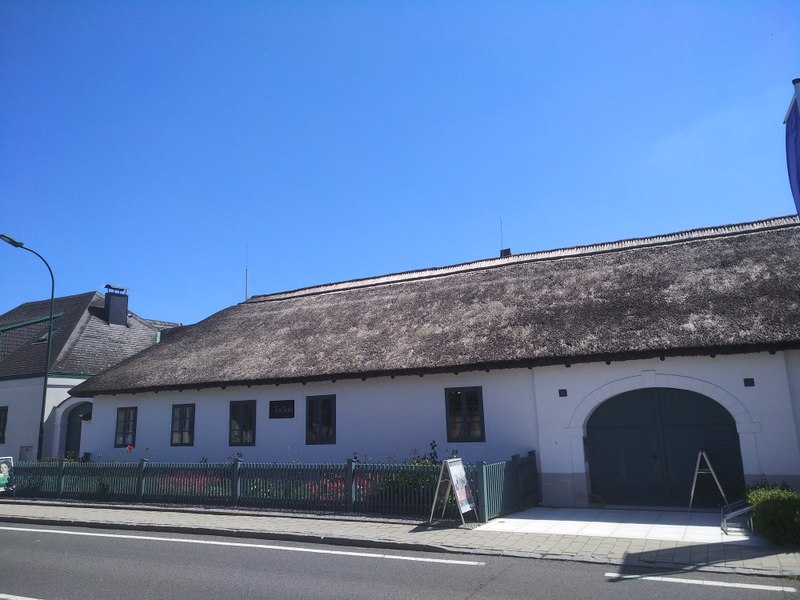
1740: 8 anys cor Sant Esteve a Viena
1749: 17 anys, acomiadat, comença a fer de freelance. Aconsegueix alguns patrons
According to Pohl, it was in the spring or summer of 1750 that Haydn occupied his most frequently described early lodgings: a ‘miserable little garret without a stove’ (Griesinger) in the so-called Michaelerhaus, attached to the Michaelerkirche. At this time ‘his entire life was devoted to giving lessons, the study of his art, and performing. He played in serenades and in orchestras for pay, and devoted himself diligently to composition, for “when I sat at my old, worm-eaten clavier, I envied no king his good fortune”’. Here occurred the first of many strokes of luck through which, in addition to his genius and unremitting labour, he gradually improved his professional lot. Griesinger writes: In the same house … lived as well the famous poet Metastasio. He was raising one Fräulein Martinez; Haydn was engaged to give her lessons in singing and on the clavier, in return for which he received free board for three years.
1750s: comença a compondre quartets de corda pel baró Fürnberg.
1757 KAPELLMEISTER COMTE MORZIN
1757: 25 anys, Kapellmeister amb el Comte Morzin
1760: 28 anys Es casa.
Simfonies Morzin: “His pre-Esterházy symphonies (most composed for Count Morzin) comprise nos.1, 37 and 18 (the earliest); 2, 4–5, 10–11, 17, 19–20, 25, 27, 32, 107; and possibly 3 and 15.”
1761 VICE KAPELLMEISTER ESTERHAZY
1761: Esterhazy. Count Morzin soon suffered financial reverses that forced him to dismiss his musical establishment, but Haydn was quickly offered a similar job (1761) by Prince Paul Anton, head of the immensely wealthy Esterházy family. Haydn’s job title was only Vice-Kapellmeister, but he was immediately placed in charge of most of the Esterházy musical establishment, with the old Kapellmeister Gregor Werner retaining authority only for church music. When Werner died in 1766, Haydn was elevated to full Kapellmeister.
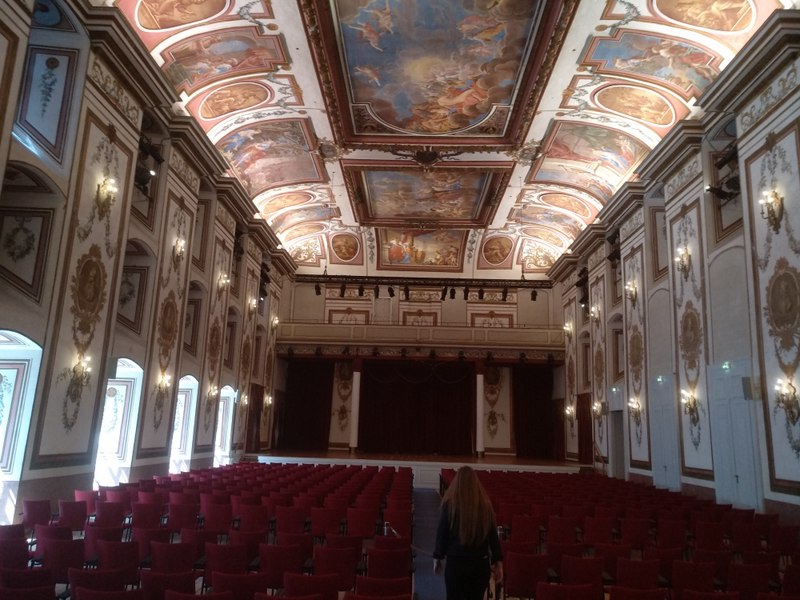
(el comte, en veure Haydn petit i moreno va preguntar “qui és aquest moro?”, i Haydn va dir qui era. Si tu ja ets al meu servei! com és que no et coneixia? Et cal un bon vestit, sabates amb taló, i una perruca.
1761 Simfonies Matí, migdia, vespre
Simfonies amb Esterhazy: Haydn’s years as Esterházy vice-Kapellmeister (1761–5) were his most productive as a symphony composer, with about 25 works (nos.6–9, 12–16, 21–4, 28–31, 33–4, 36, 39–40, 72, 108(B)); nos.35, 38 and 58–9 from about 1766–7 are similar. They exhibit great variety of style, subject matter and orchestral treatment, although the common notion that they constituted a distinctly ‘experimental’ phase is untenable. Their stylistic élan and virtuoso brilliance are attributable to the splendour of the court and the professional players now at Haydn’s disposal. One finds works for connoisseurs (nos.6–8, 13, 21–2, 31), others that seek to entertain (nos.9, 16, 33, 36, 72, 108) and still others that combine both stances (nos.34, 39–40). A few present an apotheosis of the chamber symphony: at ease, yet refined and profound (nos. 28–9, 35). Extra-musical aspects are present not only in the Matin–Midi–Soir trilogy (see §3(i)) but also nos.30 (‘Alleluja’), 31 (‘Hornsignal’), and perhaps 22 (‘The Philosopher’) and 59 (‘Fire’, a modern nickname deriving from its supposed origin as incidental music). Although a few symphonies are still in three movements (nos.9, 12, 16, 30), four is now the norm. Concertante scoring is prominent not only in nos.6–8 but in nos.9, 13, 14, 16, 31, 36, 72 and 108; a special effect found in this period alone is the use of four horns rather than the usual two (nos.13, 31, 39, 72).
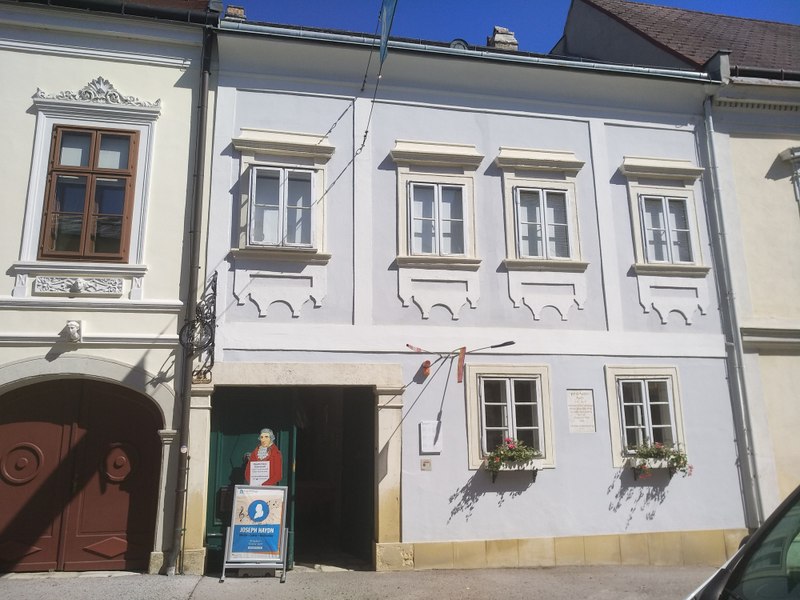
1762-1764 Quartets Op.1 Haydn. Quartets de corda
1763-1765 Quartets Op.2
Les sonates de piano d’aquest període segurament estaven pensades per a clavicèmbal i per ser interpretades per dames cultes a casa. Sonata no.2 in B (with its astonishing Largo) [HobXVI2, sonata 11, 1760] are more intellectually difficult and stylistically uncompromising than all the early quartets and most of the early symphonies; many works are small and unpretentious and were presumably written for students and amateurs. At least 12 weighty connoisseurs’ sonatas originated in the late 1760s and early 1770s, including nos.19, 20, 45, 46 and seven lost works. Two sets in mixed style followed, nos.21–6 (1773) and 27–32 (1774–6); they include serious works such as the boldly formed nos.22 in E and 26 in A, the passionate no.32 in B minor and the through-composed no.30 in A, as well as numerous lighter works, especially in the 1774–6 set. In 1780 followed Haydn’s first publication with Artaria, the heterogeneous nos.35–9 and 20, including the ‘easy’ no.35 in C, the virtuoso no.37 in D and the serious no.36 in C minor. The three modestly scaled sonatas nos.40–42 (published 1784) are miracles of popular appeal allied with high art, especially no.40 in G. Except for no.51 in D, for Mrs Schroeter, Haydn’s last five sonatas eschew any pretence of modesty. In the late 1780s he composed no.48 in C, with a fantasy-like slow variation movement and a dashing sonata-rondo finale, and the intimate no.49 in E for Mme Genzinger; its brilliant first movement has an unusually long coda and the ABA Adagio is richly expressive, with continual variations of the theme. From London come two virtuoso sonatas for Jansen: nos.50 in C and 52 in E. The former features a remarkable first movement which, though in sonata form, is based on continual variation of a basic motif; the latter is on the largest scale throughout and features a slow movement in the remote key of E major (a tonal relation adumbrated in the development of the first movement and wittily ‘cancelled’ at the beginning of the finale).
Trios de piano 1 – 17, predomina el paper del piano, que a l’època no sonava gaire fort i podia ser fàcilment eclipsat pel violí i cello.
Haydn’s piano trios have been undervalued, in part because of the great distance between their original generic identity and today’s conceptions. 18th-century keyboard trios (like violin sonatas) were understood as ‘accompanied sonatas’: the keyboard dominates, the cello mainly doubles the left hand of the piano in a pitch-class sense, and even the violin is generally more accompanimental than soloistic, although it often receives sustained melodies in second themes, slow movements, minuet trios and rondo episodes. Nevertheless the strings are essential, for integration of the texture, tone colour and rhythmic definition.
[període Sturm und Drang] 1770
1769 Quartets Op.9
Simfonies Sturm und Drang: Haydn’s symphonies of the years around 1770 (nos.26, 41–9, 52, 65) are widely described as exemplifying his Sturm und Drang style; those of 1773–4 (nos.50, 51, 54–7, 60, 64), while less extreme, have many points of contact with it. The most commonly cited feature is the minor mode – of Haydn’s ten symphonies in the minor, six fall between 1765 and 1772 – although most works remain in the major, and most of the novel stylistic features are independent of mode. These include remote keys (no.45, ‘Farewell’, in F minor and major, and no.46 in B major), rhythmic and harmonic complexities, expansion of outward dimensions and harmonic range, rhythmic instability, extremes of dynamics and register, greater technical difficulty, increased use of counterpoint (e.g. in the canonic minuet of no.44, ‘Mourning’), musical ideas that seem dynamically potential rather than self-contained, and contrast within themes instead of merely between them. The slow movements and finales become more nearly comparable to the first movements in size and weight; in the former the violins play con sordino and the tempo is usually slowed to Adagio. No.26 (‘Lamentatione’) has religious associations and no.49 (‘La passione’) may have as well. The programmatic nos.45–6 (they seem to be a pair) are integrated in a through-composed, end-orientated manner not seen again until Beethoven’s Fifth Symphony.
simfonia 44, Farewell 45
1771 piano sonata Cm XVI/20 L33, indicacions de dinàmica que revelarien que ja són per a ser interpretades al fortepiano.
1772 Quartets del sol Op.20
1761 amb el príncep Paul Anton Esterhazy i Nikolaus Esterhazy. Tenia la responsabilitat de compondre, dirigir l’orquestra i muntar òperes.
Simfonies 1775 1780. From about 1775 (in some respects 1773) to 1781 Haydn again changed his orientation. Symphonies nos.53, 61–3, 66–71 and 73–5 are primarily in a light, even popular style (only no.70 is an exception), perhaps reflecting his resumption of operatic composition in 1773; indeed nos.53, 62, 63 and 73 include adaptations of stage-music (see §3(iii)), as had nos.50 (1773) and 60 (1774) before them. This stylistic turn has been interpreted as a kind of relaxation, or even as an outright selling out, but it is better understood as representing the distinct artistic stance of entertainment. They are easy (as Haydn was to say of nos.76–8), but superbly crafted, and abound in striking and beautiful passages, not to mention witty and eccentric ones: works of comic genius that approach the buffa stage. The slow movements exhibit new formal and stylistic options (the hymn-like no.61, the exquisitely ‘popular’ theme in no.53, the play of comic and serious in no.68, the ethereal dream in no.62), while the finales adumbrate rondo and hybrid forms. Slow introductions become important about 1779 and begin to create tangible links to the allegros (nos.53, 71 and 73).
1779 renegocia el contracte que li permet compondre per a altres (fins ara tot era propietat dels Esterhazy) i això es tradueix en menys òperes, més quartets i simfonies.
Simfonies 1780-1785 During the 1780s Haydn’s style changed again, as he began to sell his symphonies abroad, in ‘opus’ format (see §3(iv) above). Although in many respects nos.76–81 (1782–4) are still ‘easy’, they include superb movements such as the opening Vivace of no.81 and the finales of nos.77 (with its contrapuntal development) and 80 (with its cross-rhythm theme). In nos.78 and 80 Haydn returns to the minor, although from no.80 on he usually ends such movements in the major, and places the entire finale in the major as well. The Paris symphonies (nos.82–7) are the grandest he had yet composed. Nos.87, 83 and 85 (1785) already have a new esprit, a combination of learned and popular style, consistency of musical argument and depth of feeling; see the slow movements of nos.83 and 87 and the outer movements of no.85 (the opening Vivace is particularly graceful and harmoniously constructed). In nos.82 and 86 (1786) the trumpets and drums lend added brilliance and the outer movements are on a still larger scale; the Capriccio of no.86 is one of Haydn’s most original slow movements. All these features characterize nos.88 and 90–92 as well (no.89 falls off somewhat). Nos.88 and 92 are the best-known: the former boasts concentrated, in part contrapuntal, outer movements, while the gorgeous Largo theme is set off by entries of the trumpets and drums (withheld from the first movement for this purpose); the latter features an unusually close integration of slow introduction and Allegro, a beautiful Adagio, rhythmically intricate trio and Haydn’s sprightliest and wittiest finale to date.
1781 Quartets op.33, Russos (el 1782 Mozart dedica a Haydn els seus 6 quartets) Haydn. Quartets de corda
1784 Quartet Op. 42
1787 Quartets OP. 50 Prussian
Trios 18 a 23
The effort to hear Haydn’s 27 late piano trios (hXV:5–31, 1784–96) with 18th-century ears is worth making: after the quartets they comprise his largest and greatest corpus of chamber music.
No.12 in E minor (1788–9) [XV 12, 25] has an opening movement of astonishing seriousness with vast expansions towards the end, while the beautiful siciliano slow movement and the ebullient rondo finale are both in E major. No.14 in A (1789–90)[ XV 14 25 includes his first slow movement in a remote key (E major, or VI, adumbrated by B major in the development of the first movement).
Viatges a Londres 1791-1792 i 1794-1795
1790 és famós a tot Europa però està reclòs a Esterhazy. Mor el príncep Nikolaus i el successor mira de reduir despeses. Se li rebaixa el sou però pot viatjar i se’n va a London contractat per l’empresari Salomon [com els productors de jazz]. He spent some of the time in the country (Hertingfordbury), but also had time to travel, notably to Oxford, where he was awarded an honorary doctorate by the University.
In the 1790s, stimulated by his England journeys, Haydn developed what Rosen calls his “popular style”, a method of composition that, with unprecedented success, created music having great popular appeal but retaining a learned and rigorous musical structure.[n 27] An important element of the popular style was the frequent use of folk or folk-like material, as discussed in the article Haydn and folk music. Haydn took care to deploy this material in appropriate locations, such as the endings of sonata expositions or the opening themes of finales. In such locations, the folk material serves as an element of stability, helping to anchor the larger structure.[57] Haydn’s popular style can be heard in virtually all of his later work, including the twelve London symphonies, the late quartets and piano trios, and the two late oratorios.
1788 Quartets Opus 54-55, Tost I Haydn. Quartets de corda
1790 Quartets Opus. 64, Tost II
Trios 24 a 31: From London, nos.24–6 (1794–5), dedicated to Schroeter, include no.25 (with the famous ‘Gypsy Rondo’) and no.26 in the special key of F minor: following a concentrated and brooding Allegro and a gorgeous Adagio in F major (identical in substance with the Adagio of Symphony no.102), the minuet-finale is anything other than anticlimactic. It begins dissonantly on a dominant 9th and this instability is maintained throughout: there is no tonic cadence until the very last bar of the A section, just before the double bar, and in the reprise even this cadence is deceptive, leading to a substantial coda. Rosen praises its ‘intimate gravity … a melancholy so intense it is indistinguishable from the tragic’, while Landon conjectures that the work may represent Haydn’s farewell to Mrs Schroeter (the key is suggestive). By contrast, nos.27 in C and 29 in E (1795–6), dedicated to Jansen, are difficult and extroverted; no.29 is particularly original in construction, and both have rollicking finales that outdo any earlier ones.
1791 Orfeo i Eurídice. Un encàrrec. Algun problema entre el rei i el príncep de Gal·les va impedir que s’estrenés. Va quedar inèdita fins 1951.
1793 Quartets Opus 71, 74 Apponyi
Simfonies London, 93-104 Haydn’s London symphonies (nos.93–104) crown his career as a symphonic composer. Not only do they outdo the Paris symphonies stylistically, but he produced them in person for rapturous audiences; this interaction stimulated him to ever bolder and more original conceptions. Nos.95–6 (1791) most nearly resemble the preceding symphonies, although no.95 in C minor has a gripping opening movement dominated by a striking unison motto, an ominously terse minuet and a brilliant sonata-fugal finale in C major (possibly influenced by the finale of Mozart’s ‘Jupiter’). Those given in 1792 (nos.93–4, 97–8) respond to Haydn’s public: in no.94 the famous outburst in the Andante is actually the least remarkable ‘surprise’; the opening Vivace reaches new heights of tonal wit and expansive brilliance, and the concluding sonata-rondo is the first to exhibit the blend of rhythmic vitality, playful surprise, larger scale and underlying cogency of argument that distinguish Haydn’s London finales. These last features are found in nos.97–8 as well, along with a new romanticism in the opening movement of no.97 (the breathtaking diminished 7th chord in bar 2, which returns at several key points, and the remote flat-side modulations in the recapitulation); in no.98 Haydn composed an extended fortepiano obbligato for himself in the coda of the finale.
TRIOS
Three trios (H. XV:18–20) dedicated to Princess Maria Anna, wife of Prince Anton Esterházy:
No. 32 in A major, Hoboken XV:18 (1793)
No. 33 in G minor, Hoboken XV:19 (1793)
No. 34 in B♭ major, Hoboken XV:20 (1794)
Three trios (H. XV:21–23) dedicated to Princess Maria Josepha, wife of Prince Nicholas Esterházy:
No. 35 in C major, Hoboken XV:21 (1794)
No. 36 in E♭ major, Hoboken XV:22 (1794)
No. 37 in D minor, Hoboken XV:23 (1794)
Three trios (H. XV:24–26) dedicated to Rebecca Schroeter:
1795 Torna a Viena, ara cèlebre
La Creació
Les estacions
Concert per a trompeta
Últimes sis simfonies. The last six symphonies are even more brilliant (clarinets are added, except in no.102); Haydn’s determination to conquer new territory with each work is palpable. No.99 in E is his most elaborate symphonic essay in remote tonal relations; it also features a particularly warm slow movement (in G major), with extensive wind writing (much commented on at the time). No.101 (‘Clock’) has by far the longest minuet and trio Haydn ever composed and a particularly brilliant rondo finale. No.100 (‘Military’) rapidly became his most popular, owing to the slow movement based on a romance (from the lyre concerto hVIIh:3), overlaid by massive percussion outbursts that audiences found deliciously terrifying. No.102 is the least ‘characteristic’ of these six, yet one of the greatest; its most remarkable movement is the Adagio (identical in musical substance to that in the F minor Piano Trio hXV:26), in which the exposition is repeated in order to vary the instrumentation, with muted trumpets and drums. No.103 (‘Drumroll’) offers Haydn’s most telling invocation of the sublime in instrumental music, by means of an astonishing double annunciation: first the ‘intrada’ fortissimo drum roll, then the mysterious bass theme (resembling the ‘Dies irae’), which dominates the Allegro as well and, even more astonishingly, interrupts the recapitulation near the end. No.104 begins with a massive dotted motif on the 5th D–A, which some commentators describe as dominating the entire symphony (fig.13); the first movement is one of Haydn’s freest and the finale has greater relative weight than that in any other of the London symphonies.
1796 – 97 Quartets Opus 76 Erdödy Haydn. Quartets de corda
1799 Quartets Opus 77, Lobkowitz
TRIOS
No. 38 in D major, Hoboken XV:24 (1795)
No. 39 in G major, Hoboken XV:25 (1795) “Gypsy”
No. 40 in F♯ minor, Hoboken XV:26 (1795)
Two stand-alone trios (H. XV:31, 30):
No. 41 in E♭ minor, Hoboken XV:31 (1797) “Jacob’s Dream”
No. 42 in E♭ major, Hoboken XV:30 (1797)
Three trios (H. XV:27–29), known as the “Bartolozzi Trios,” dedicated to Theresa Jansen (Bartolozzi):
No. 43 in C major, Hoboken XV:27 (1797)
No. 44 in E major, Hoboken XV:28 (1797)
No. 45 in E♭ major, Hoboken XV:29 (1797
1803 Físicament malalt, pero segueix tenint idees: [Haydn said] “I must have something to do—usually musical ideas are pursuing me, to the point of torture, I cannot escape them, they stand like walls before me. If it’s an allegro that pursues me, my pulse keeps beating faster, I can get no sleep. If it’s an adagio, then I notice my pulse beating slowly. My imagination plays on me as if I were a clavier.”[n 16] Haydn smiled, the blood rushed to his face, and he said “I am really just a living clavier.”
Es compra la casa amb jardí a Viena [foto]. Die Phantasie spielt mich, als wie ein Klavier.
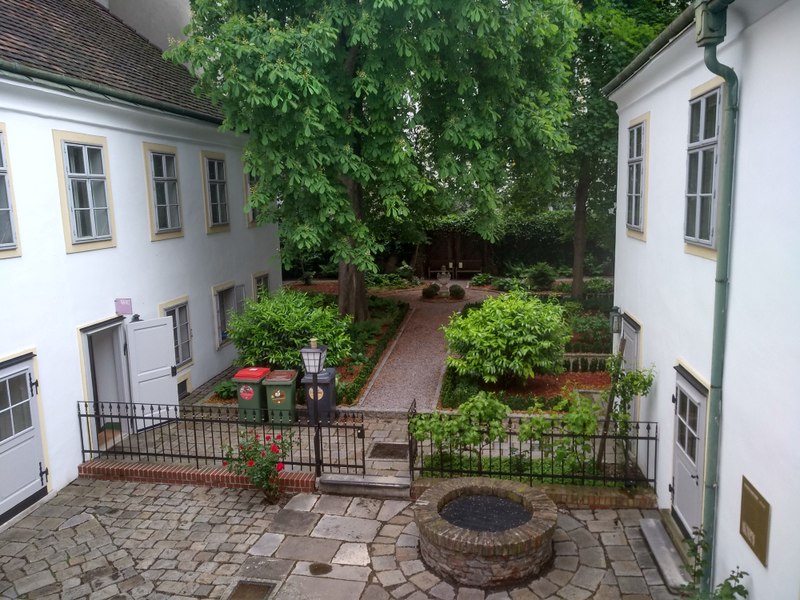
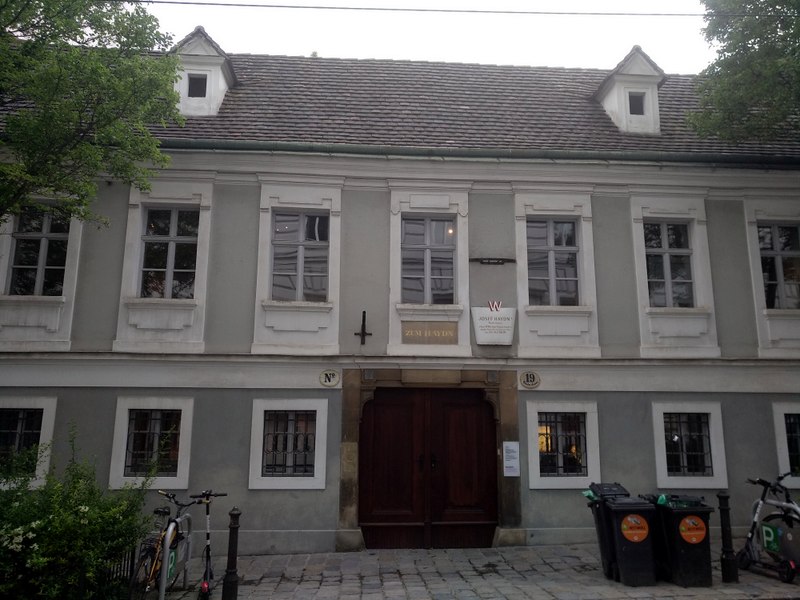
Mausoleu a l’església d’Eisenstadt
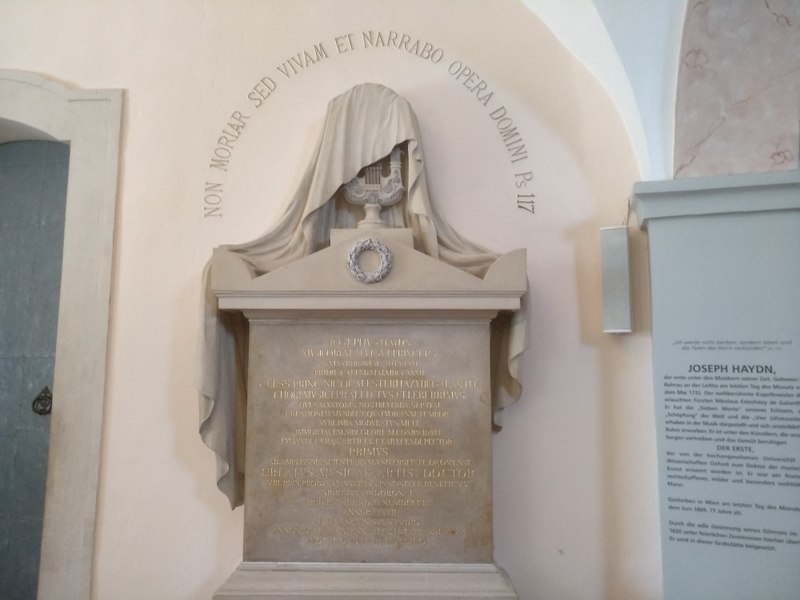
Conservatori a Eisenstadt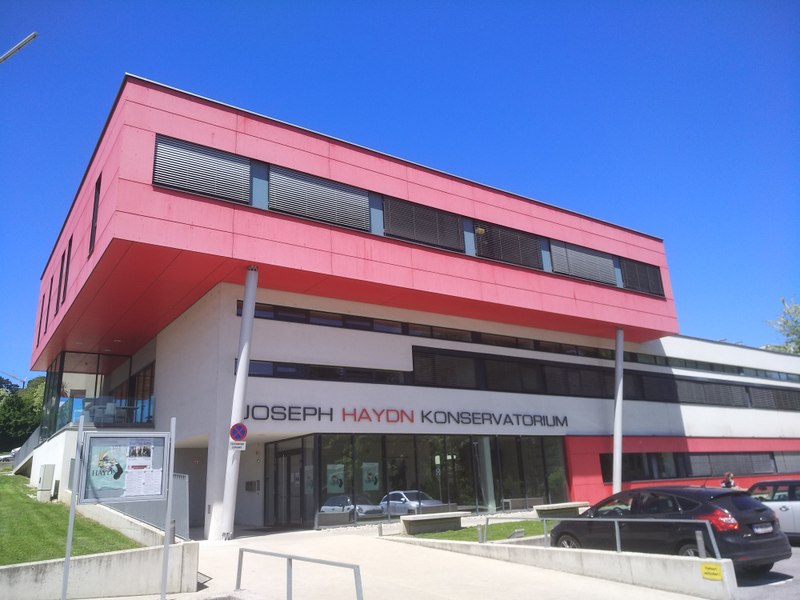
- 0630 llevar-se
- 0800 Esmorzar i tocar el piano
- 1130 Visites
- 1400 Dinar
- 1600 Escriure música
- 2000 Passeig
- 2200 Sopar
- 2330 Dormir
Of these, a particularly important one was with Maria Anna von Genzinger (1754–93), the wife of Prince Nikolaus’s personal physician in Vienna, who began a close, platonic, relationship with the composer in 1789. Haydn wrote to Mrs. Genzinger often, expressing his loneliness at Esterháza and his happiness for the few occasions on which he was able to visit her in Vienna; later on, Haydn wrote to her frequently from London. Her premature death in 1793 was a blow to Haydn, and his F minor variations for piano, Hob. XVII:6, may have been written in response to her death [vol 11 18m]
Perhaps more than any other composer’s, Haydn’s music is known for its humor.[53] The most famous example is the sudden loud chord in the slow movement of his “Surprise” symphony; Haydn’s many other musical jokes include numerous false endings (e.g., in the quartets Op. 33 No. 2 and Op. 50 No. 3), and the remarkable rhythmic illusion placed in the trio section of the third movement of Op. 50 No. 1.[54] Much of the music was written to please and delight a prince, and its emotional tone is correspondingly upbeat.
